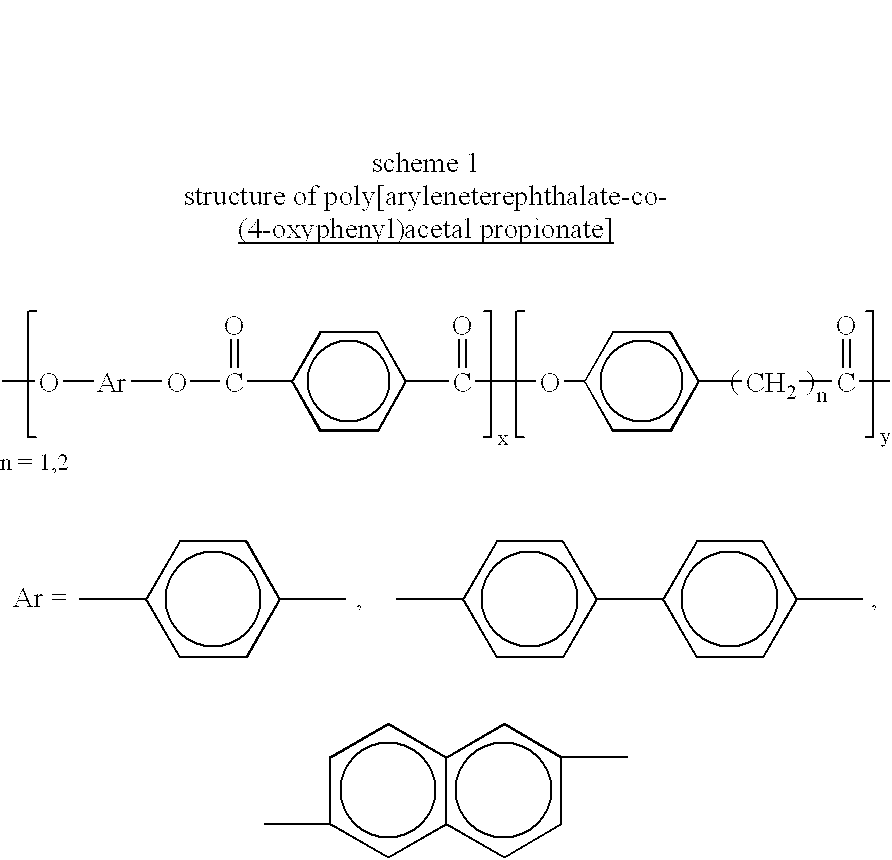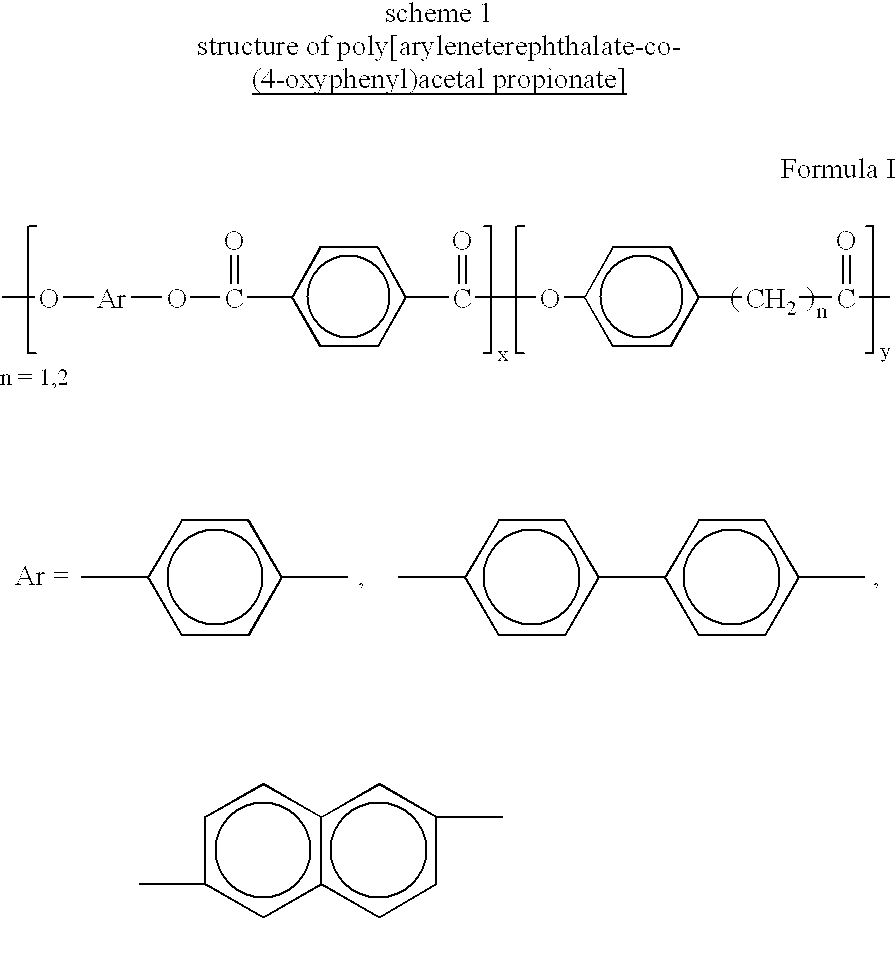Melt processible thermotropic liquid crystalline terpolyesters and process for the preparation thereof
a technology of thermotropic liquid crystalline terpolyester and melt process, which is applied in the direction of electrical equipment, printed circuits, group 4/14 element organic compounds, etc., can solve the problems of low heat distortion temp (90.degree. c), low molecular weight of polymer, and low thermal stability
- Summary
- Abstract
- Description
- Claims
- Application Information
AI Technical Summary
Benefits of technology
Problems solved by technology
Method used
Image
Examples
example 2
In a 60 ml polymerisation tube 0.033 mol of 3(4-hydroxyphenyl)propionic acid, 0.033 mol of hydroquinone, and 0.033 mol of terephthalic acid were taken mixed with 0.08 mol of acetic anhydride and 0.01 mmol of magnesium acetate were added and heated under slow stirring in a slow purge of nitrogen to 140.degree. C. and continued the heating for 1 / 2+L hr. Then temperature was increased to 250-300.degree. C. and continued for 2-3 hrs. in presence of 3 ml of high temperature solvent Dowtherm.RTM.. Polymerisation was further continued at 0.01 mm of Hg pressure for 1-2 hrs. Then the polymer was chipped out of the tube and purified by soxhlet extraction using acetone / isopropanol mixture for about 18 hrs and dried in an air oven at 60.degree. C. for about 3 hrs at reduced pressure.
example 3
In a 60 mol polymerisation tube 0.02 mol of 4-hydroxyphenyl acetic acid, 0.04 mol of 4,4'-biphenol, and 0.02 mol of terephthalic acid were taken mixed with 0.08 mol of acetic anhydride and 0.01 mmol of magnesium acetate were added and heated under slow stirring in a slow purge of nitrogen to 140.degree. C. and continued the heating for 1 / 2+L hr. Then the temperature was increased to 240-300.degree. C. and continued for 2-3 hrs. Polymerisation was further continued at 0.01 mm of Hg pressure for 1-2 hrs. Then the polymer was chipped out of the tube and purified by soxhlet extraction using acetone-isopropanol mixture for about 18 hrs and dried in an air oven at 60.degree. C. for about 3 hrs at reduced pressure.
example 4
In a 60 ml polymerisation tube 0.033 mol of 3(4-hydroxyphenyl)propionic acid, 0.033 mol of 4,4'-biphenol, and 0.033 mol of terephthalic acid were taken mixed with 0.08 mol of acetic anhydride and 0.01 mmol of magnesium acetate were added and heated under slow stirring in a slow purge of nitrogen to 140.degree. C. and continued the heating for 1 / 2+L hr. Then temperature was increased to 250-300.degree. C. and continued for 2-3 hrs in presence of 3 ml of high temperature solvent Dowtherm.RTM.. Polymerisation was further continued at 0.01 mm of Hg pressure for 1-2 hrs. Then the polymer was chipped out of the tube and purified by soxhlet extraction using acetone-isopropanol mixture for about 18 hrs and dried in an air oven at 60.degree. C. for about 3 hrs at reduced pressure.
PUM
| Property | Measurement | Unit |
|---|---|---|
| temperatures | aaaaa | aaaaa |
| temperature | aaaaa | aaaaa |
| decomposition temperature | aaaaa | aaaaa |
Abstract
Description
Claims
Application Information
 Login to View More
Login to View More - Generate Ideas
- Intellectual Property
- Life Sciences
- Materials
- Tech Scout
- Unparalleled Data Quality
- Higher Quality Content
- 60% Fewer Hallucinations
Browse by: Latest US Patents, China's latest patents, Technical Efficacy Thesaurus, Application Domain, Technology Topic, Popular Technical Reports.
© 2025 PatSnap. All rights reserved.Legal|Privacy policy|Modern Slavery Act Transparency Statement|Sitemap|About US| Contact US: help@patsnap.com



